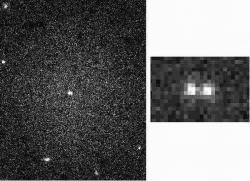 To form a supermassive black hole, you’d think it takes a really large galaxy, like the Milky Way or Andromeda. But it appears that these monsters can form at the heart of plain old dwarf galaxies too.
To form a supermassive black hole, you’d think it takes a really large galaxy, like the Milky Way or Andromeda. But it appears that these monsters can form at the heart of plain old dwarf galaxies too.
An international team of astronomers presented this discovery at the American Astronomical Society national meeting in Seattle. They were searching through archives of photographs taken by the Hubble Space Telescope, looking for dwarf galaxies. The nuclei of these galaxies are thought to form from globular star clusters.
Dwarf galaxy VCC128, which lies in the Virgo Cluster, is only 1% the size of the Milky Way. But they noticed that it has a double nucleus. They discovered that this double nucleus is actually the two sides of a ring of stars surrounding a black hole. As supermassive black holes go, it’s not as large as our own, but it still contains 1 million to 50 million times the mass of the Sun.
This could mean that other dwarf galaxies with dwarf nuclei contain black holes of their own, raising the possibility that every galaxy contains a black hole.
